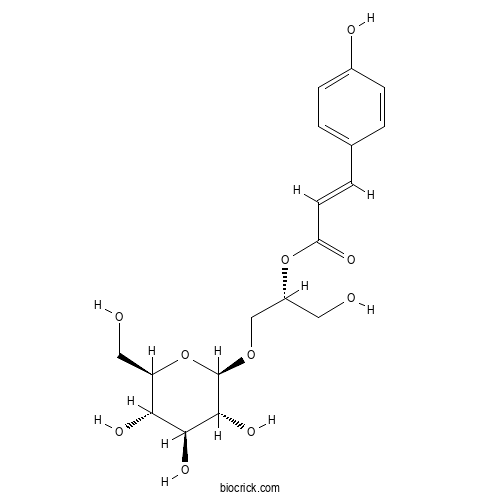Regaloside HCAS# 126239-77-8 |

Quality Control & MSDS
3D structure
Package In Stock
Number of papers citing our products

| Cas No. | 126239-77-8 | SDF | Download SDF |
| PubChem ID | 14542288.0 | Appearance | Powder |
| Formula | C18H24O10 | M.Wt | 400.38 |
| Type of Compound | Phenols | Storage | Desiccate at -20°C |
| Solubility | Soluble in Chloroform,Dichloromethane,Ethyl Acetate,DMSO,Acetone,etc. | ||
| Chemical Name | [(2R)-1-hydroxy-3-[(2R,3R,4S,5S,6R)-3,4,5-trihydroxy-6-(hydroxymethyl)oxan-2-yl]oxypropan-2-yl] (E)-3-(4-hydroxyphenyl)prop-2-enoate | ||
| SMILES | C1=CC(=CC=C1C=CC(=O)OC(CO)COC2C(C(C(C(O2)CO)O)O)O)O | ||
| Standard InChIKey | WYSRAMKKFNDRPR-BFQBLSCMSA-N | ||
| Standard InChI | InChI=1S/C18H24O10/c19-7-12(27-14(22)6-3-10-1-4-11(21)5-2-10)9-26-18-17(25)16(24)15(23)13(8-20)28-18/h1-6,12-13,15-21,23-25H,7-9H2/b6-3+/t12-,13-,15-,16+,17-,18-/m1/s1 | ||
| General tips | For obtaining a higher solubility , please warm the tube at 37 ℃ and shake it in the ultrasonic bath for a while.Stock solution can be stored below -20℃ for several months. We recommend that you prepare and use the solution on the same day. However, if the test schedule requires, the stock solutions can be prepared in advance, and the stock solution must be sealed and stored below -20℃. In general, the stock solution can be kept for several months. Before use, we recommend that you leave the vial at room temperature for at least an hour before opening it. |
||
| About Packaging | 1. The packaging of the product may be reversed during transportation, cause the high purity compounds to adhere to the neck or cap of the vial.Take the vail out of its packaging and shake gently until the compounds fall to the bottom of the vial. 2. For liquid products, please centrifuge at 500xg to gather the liquid to the bottom of the vial. 3. Try to avoid loss or contamination during the experiment. |
||
| Shipping Condition | Packaging according to customer requirements(5mg, 10mg, 20mg and more). Ship via FedEx, DHL, UPS, EMS or other couriers with RT, or blue ice upon request. | ||

Regaloside H Dilution Calculator

Regaloside H Molarity Calculator
| 1 mg | 5 mg | 10 mg | 20 mg | 25 mg | |
| 1 mM | 2.4976 mL | 12.4881 mL | 24.9763 mL | 49.9525 mL | 62.4407 mL |
| 5 mM | 0.4995 mL | 2.4976 mL | 4.9953 mL | 9.9905 mL | 12.4881 mL |
| 10 mM | 0.2498 mL | 1.2488 mL | 2.4976 mL | 4.9953 mL | 6.2441 mL |
| 50 mM | 0.05 mL | 0.2498 mL | 0.4995 mL | 0.9991 mL | 1.2488 mL |
| 100 mM | 0.025 mL | 0.1249 mL | 0.2498 mL | 0.4995 mL | 0.6244 mL |
| * Note: If you are in the process of experiment, it's necessary to make the dilution ratios of the samples. The dilution data above is only for reference. Normally, it's can get a better solubility within lower of Concentrations. | |||||

Calcutta University

University of Minnesota

University of Maryland School of Medicine

University of Illinois at Chicago

The Ohio State University

University of Zurich

Harvard University

Colorado State University

Auburn University

Yale University

Worcester Polytechnic Institute

Washington State University

Stanford University

University of Leipzig

Universidade da Beira Interior

The Institute of Cancer Research

Heidelberg University

University of Amsterdam

University of Auckland

TsingHua University

The University of Michigan

Miami University

DRURY University

Jilin University

Fudan University

Wuhan University

Sun Yat-sen University

Universite de Paris

Deemed University

Auckland University

The University of Tokyo

Korea University
- 3β,13-dihydroxy-ursan-28-oic acid-13-lactone
Catalog No.:BCX1038
CAS No.:29428-70-4
- 6-Iodo 5,7,3',4',5'-Pentamethoxyflavone
Catalog No.:BCX1037
CAS No.:1192850-63-7
- α-Norbixin
Catalog No.:BCX1036
CAS No.:626-76-6
- Isoferulic Acid
Catalog No.:BCX1035
CAS No.:537-73-5
- Acetylalkannin
Catalog No.:BCX1034
CAS No.:34232-27-4
- Agrimoniin
Catalog No.:BCX1033
CAS No.:82203-01-8
- Ciwujianoside C1
Catalog No.:BCX1032
CAS No.:114906-73-9
- Ciwujianoside C4
Catalog No.:BCX1031
CAS No.:114906-75-1
- Ciwujianoside D1
Catalog No.:BCX1030
CAS No.:114912-35-5
- Ciwujianoside D2
Catalog No.:BCX1029
CAS No.:114892-57-8
- 6-Hydroxymusizin 8-glucoside
Catalog No.:BCX1028
CAS No.:23566-96-3
- 18α,20β-Glycyrrhizic acid
Catalog No.:BCX1027
CAS No.:83896-44-0
- (+)-trans-Khellactone
Catalog No.:BCX1040
CAS No.:20516-17-0
- (-)-cis-Khellactone
Catalog No.:BCX1041
CAS No.:54712-23-1
- L-1,2,3,4-Tetrahydronorharman-3-carboxylic acid
Catalog No.:BCX1042
CAS No.:42438-90-4
- 13β,21-Dihydroxyeurycomanone
Catalog No.:BCX1043
CAS No.:138874-44-9
- Wilforlide B
Catalog No.:BCX1044
CAS No.:84104-70-1
- Advantame
Catalog No.:BCX1045
CAS No.:714229-20-6
- Rhododenol
Catalog No.:BCX1046
CAS No.:69617-84-1
- Fischeroside C
Catalog No.:BCX1047
CAS No.:1307257-09-5
- 2"-Acetylhyperin
Catalog No.:BCX1048
CAS No.:439266-62-3
- Pterostilbene glucoside
Catalog No.:BCX1049
CAS No.:38967-99-6
- 3'-O-Acetylhamaudol
Catalog No.:BCX1050
CAS No.:30358-88-4
- Phenaxolactone 1
Catalog No.:BCX1051
CAS No.:147022-96-6
Analysis of edible characteristics, antioxidant capacities, and phenolic pigment monomers in Lilium bulbs native to China.[Pubmed:34980390]
Food Res Int. 2022 Jan;151:110854.
Lilium is cherished for its health-promoting properties in China. The bulbs of Lilium are rich in phenolic compounds, which are associated with antioxidant capacity. However, no systematic evaluation on phenolic compositions and antioxidant capacities for the edible Lilium native to China has been conducted. Herein, bulbs of 56 wild populations and three cultivars were collected. Their edible characteristics, antioxidant capacities, and pigments have been investigated and analyzed. The results showed that phenolic compounds contributed to the major colors (red, yellow and white) in Lilium bulbs. The seven phenolic pigment monomers responsible for the color of bulbs-cyanidin-3-O-rutinoside, isoquercitrin, regaloside B, regaloside C, Regaloside H, regaloside A and regaloside D-were identified by the combination of HPLC-MS and NMR analysis. The population Lilium regale E. H. Wilson (Maoxian County, Sichuan Province) had the highest antioxidant capacity. According to the quantification results, Lilium bulbs with darker and redder colors possessed larger biomass, better nutrient compositions, significantly higher bioactive constituents, and higher antioxidant capacities than the three currently consumed cultivars of edible lily bulbs. Overall, these findings suggest that the mountainous area of southwest China could be the fourth source of edible lilies with the bulb-colored Lilium species.


